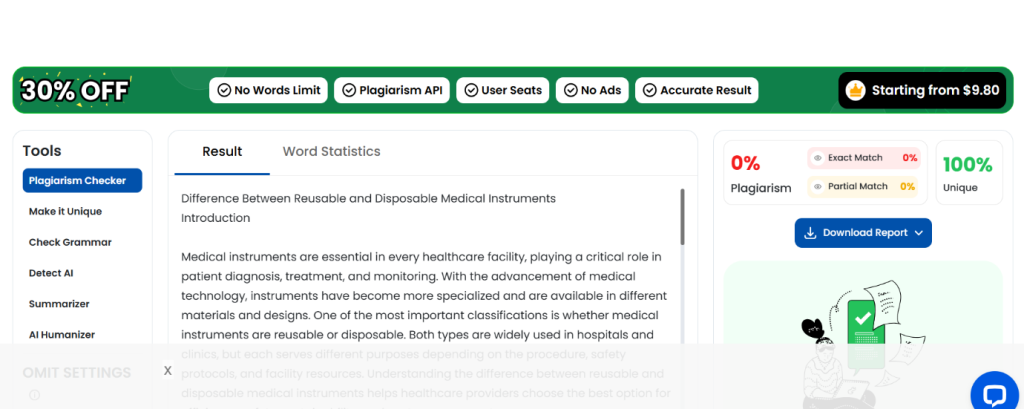
Infection control is one of the most crucial responsibilities in any healthcare environment. Every day, hospitals, clinics, and laboratories handle instruments that come into direct contact with patients. If these tools are not properly sterilized, harmful microorganisms such as bacteria, viruses, and fungi can spread, leading to serious healthcare-associated infections (HAIs). These infections not only increase treatment costs and patient recovery time but can also become life-threatening. This is why sterilization equipment is considered a backbone of modern medical safety protocols.
How Sterilization Protects Patients and Healthcare Workers
Sterilization equipment ensures that every medical instrument used during surgeries, diagnostic tests, and routine procedures is completely free of contaminants. Unlike basic cleaning or disinfection, sterilization eliminates all forms of microbial life, including resistant spores. Today, healthcare facilities rely on advanced sterilization systems to protect patients, reduce infection rates, and comply with global healthcare quality standards.
Types of Sterilization Equipment Used in Healthcare
Modern sterilization technology has evolved significantly over the years. The most common type used in hospitals is the autoclave, which uses pressurized steam to kill microorganisms. It is highly effective, cost-efficient, and suitable for a wide range of metal and heat-resistant instruments. For more delicate tools, such as plastic or electronic equipment, low-temperature sterilization methods like ethylene oxide gas (ETO), hydrogen peroxide plasma, and ozone sterilizers are used. These methods ensure that sensitive instruments do not get damaged while still achieving complete sterilization.
Breaking the Chain of Infection
Sterilization equipment plays a direct role in breaking the chain of infection. When a contaminated instrument is reused, it becomes a vehicle for pathogens, exposing the next patient or even the healthcare worker to infection. Types of infections prevented through sterilization include surgical site infections, bloodstream infections, and respiratory infections. Without reliable sterilization systems, even minor medical procedures could pose severe risks.
Steps in the Sterilization Process
Sterilization is a step-by-step process, not just a single action. Before entering the sterilization chamber, instruments undergo inspection, cleaning, and packaging. Mechanical washers and ultrasonic cleaners remove any visible debris. Once cleaned, instruments are packaged to protect them after sterilization. Specialized indicators placed inside the packaging verify whether the sterilization process achieved the correct temperature and exposure time. Finally, sterilized instruments are stored in controlled environments to prevent recontamination before use. Each step is monitored to ensure compliance with strict hospital hygiene standards.
Quality Control and Staff Training
Another critical factor in infection prevention is the proper maintenance of sterilization equipment. These machines require regular calibration, temperature validation, and physical condition checks. Hospital staff must be thoroughly trained in loading patterns, sterilization cycles, and correct handling methods. Even a minor mistake, such as overloading the chamber, can reduce sterilization effectiveness. Therefore, quality assurance programs are implemented to maintain consistent safety levels.
Environmental and Cost Benefits
Sterilization equipment also supports environmental sustainability in the medical field. By enabling safe reuse of tools, hospitals reduce excess waste generated from disposable instruments. While single-use devices are still necessary in many situations, the ability to sterilize and reuse durable medical instruments helps minimize environmental impact and reduce supply costs. Moreover, advanced sterilizers are increasingly designed to consume less energy and water, making them more eco-friendly.
Lessons Learned from the COVID-19 Pandemic
The COVID-19 pandemic highlighted the importance of sterilization technology more than ever. During global shortages of supplies such as masks and personal protective equipment, healthcare facilities relied on sterilization systems to safely reuse essential items. This demonstrated how robust sterilization protocols can increase a hospital’s resilience during health crises.
Compliance with Global Health Standards
Every country has strict regulations regarding sterilization in medical facilities. Compliance ensures patient safety and protects healthcare workers from occupational exposure. International guidelines from organizations such as the World Health Organization (WHO) and Centers for Disease Control and Prevention (CDC) provide standardized sterilization practices used worldwide. Regular audits and monitoring are mandatory to confirm that sterilization equipment is operating correctly and staff members are following approved procedures.
Future Innovations in Sterilization Technology
Looking ahead, advancements in sterilization technology continue to improve infection control. Automated digital systems are replacing manual documentation, reducing errors and improving traceability. New sterilization techniques using UV-C light and vaporized disinfectants are being developed for faster and contact-free sterilization. Integration with smart monitoring systems will further enhance accuracy and safety.
Conclusion
Infection prevention is not just a technical requirement but a moral obligation. Sterilization equipment ensures that medical teams can carry out procedures with confidence, knowing that instruments are safe and hygienic. It reduces infection risk, improves patient outcomes, and supports sustainability. Investing in advanced sterilization systems and proper staff training is essential for any healthcare facility committed to high standards of patient safety.
If you are unable to find your desired product on our website, please don’t hesitate to contact us through the Contact Form. Our team will be happy to assist you with product availability, custom requests, or further information.
Agree Decline